
LEXINGTON, Ky. — Jesse Hoagg, Donald and Gertrude Lester professor of Mechanical Engineering at the University of Kentucky, has received a $1,199,150 grant from the National Science Foundation to use unmanned aerial vehicles (UAVs) in the event of airborne contaminant dispersion. The project, “Data-Driven Adaptive Real-Time (DART) Flow-Field Estimation Using Deployable UAVs,” is funded for three years. Mechanical engineering associate professors Sean Bailey and Alexandre Martin will serve as co-investigators, as will biosystems and agricultural engineering associate professor Michael Sama.
The Fukushima Daiichi nuclear disaster and the Aliso Canyon natural gas leak are recent high-profile examples of emergency situations that resulted from the unplanned release of an airborne contaminant. In such emergency scenarios, accurate real-time prediction of contaminant movement is invaluable for planning emergency response, protecting emergency workers, and assessing environmental impact. However, accurate prediction of contaminant dispersion is challenging because of atmospheric turbulence, ground terrain topology, and changing wind conditions.
This project addresses the problem of predicting atmospheric contaminant dispersion in real-time by using a fleet of autonomous unmanned air vehicles (UAVs) to obtain sparse physical measurements of the atmospheric flow and contaminant concentrations. Then, these sparse physical measurements are used in real time to continually improve a computational fluid dynamic model in order to produce an accurate real-time prediction of the contaminant dispersion.
The primary aim of this project is to develop and demonstrate a new data-driven adaptive real-time (DART) system that produces accurate real-time micrometeorological estimates and forecasts contaminant dispersion near its source. The DART system will consist of a computational-fluid-dynamic cyber system and a physical system of autonomous UAVs instrumented with flow sensors and contaminant-concentration sensors. Together, this DART system will produce accurate flow-field estimates, which can be used to predict contaminant dispersion.
Developing the DART system requires new techniques for real-time data-driven model adaption, advances in computational turbulence modeling, improvements in UAV-based sensing and data processing, and new UAV formation flying methods that use cyber-feedback from the computational-fluid-dynamic cyber system.
Hoagg joined the UK Engineering faculty in 2010.




















Add Comment